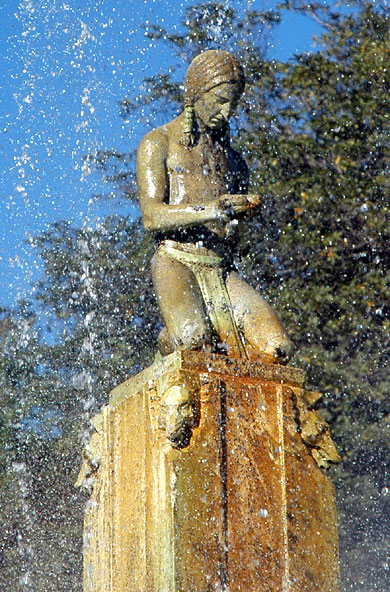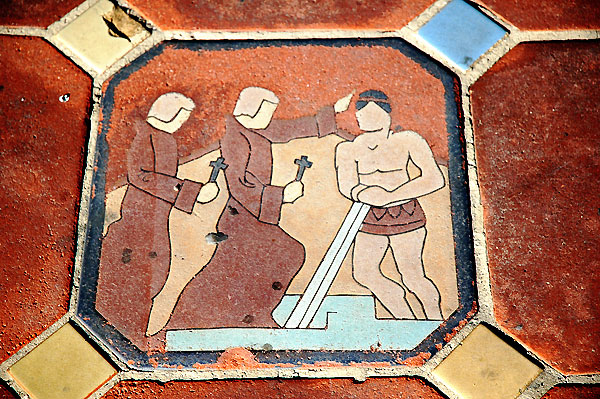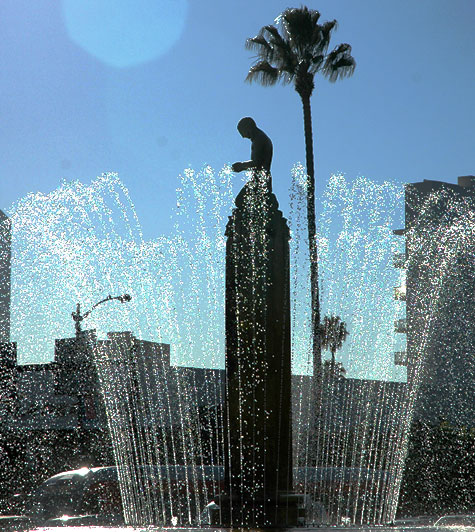Topic: Landmarks
| The Noble Savage at the Electric Fountain |
 On the northwest corner of Wilshire and Santa Monica Boulevards there's the Beverly Hilton Hotel, from 1955 and now all remodeled, with Trader Vic’s attached (the place that invented the Mai Tai and other girly drinks with the little paper parasols, and still offers that taste of the fifties, an Americanized version of what Polynesian food might be like if you never left Iowa and made it all up). On the southwest corner, across from a Starbucks that used to be leather shop where you could get a suede bomber jacket, there's Creative Artists Agency (CAA) - a big white whale of a building by Richard Meier, that fellow who did The Getty Center. It's full of major Hollywood agents, of course. On the southeast corner is the parking lot of the Beverly Hills Budget Rent-a-Car folks. Yes, you can rent a Rolls or Ferrari or Lamborghini out here. They’re all lined up there.
On the northwest corner of Wilshire and Santa Monica Boulevards there's the Beverly Hilton Hotel, from 1955 and now all remodeled, with Trader Vic’s attached (the place that invented the Mai Tai and other girly drinks with the little paper parasols, and still offers that taste of the fifties, an Americanized version of what Polynesian food might be like if you never left Iowa and made it all up). On the southwest corner, across from a Starbucks that used to be leather shop where you could get a suede bomber jacket, there's Creative Artists Agency (CAA) - a big white whale of a building by Richard Meier, that fellow who did The Getty Center. It's full of major Hollywood agents, of course. On the southeast corner is the parking lot of the Beverly Hills Budget Rent-a-Car folks. Yes, you can rent a Rolls or Ferrari or Lamborghini out here. They’re all lined up there. That leaves the northeast corner of the intersection, where there's a fancy fountain, with a sculpture of a noble savage, an Indian, or Native American if you will. The figure sits atop a plinth in the middle of the fountain, continually soaked by the waters. This whole affair is from 1931 - a far more innocent time. It seems to be a celebration of something pre-Hollywood, the days when this really was "the West" and there were real Indians and covered wagons and all the rest - long ago, before John Ford directed John Wayne in the fake version.
This is the Electric Fountain. The plaza and fountain are the work the architect Ralph Carlin Flewelling, and the sculpture is by Robert Merrell Gage. The park surrounding it all was given to the city by the Beverly Hills Residential Protective Association. It was 1931 and the Great Depression was on. It provided something to feel good about - the history of the taming of the West and all.
As for the fountain -
It is still rather spectacular.Electric fountain is said to have stopped traffic for hours when unveiled in 1931 (quoted in "Fountain Blues", New West, April 25, 1977). Originally, the Fountain's water jets and color effects were timed to give 60 different combinations every 8 minutes. Total cost of the Fountain was $22,000, $8,000 of which was spent for electrical equipment and wiring (from "Request for Determination of Eligibility for Inclusion in the National Register of Historic Places," prepared by Lois M. Webb and George Casen, p.2. also see Jennifer Ring, "Splash and Spray Around LA; A Tour of Some of the City's Classier Spouts," Westways, September 1972).
 Then there's Robert Merrell Gage -
Then there's Robert Merrell Gage - Gutzom Borglum, the man who carved the famous figures on Mount Rushmore, called Robert Merrell Gage "that steady-eyed young sculptor," and from those steady eyes came a vision of art that spoke of strong values, American values, Kansan values. An alumni of the most sophisticated art schools, Robert Merrell Gage turned for subject matter to the basics of American history, the stories of the western struggle and the lives of heroes of the American soul.
Gage was a native Topekan, born in 1892, and educated in the Topeka public schools and at Washburn College. He left Kansas after graduation to study sculpture in both New York and France with Borglum and Robert Henri, two exponents of the "American Theme" in art. Returning to Topeka in 1916, the young sculptor set up shop in a barn behind his house on Fillmore Street and began his first public commission, the magnificent statue of Lincoln that rests on the Kansas State Capitol grounds. After a stint in the armed services during World War I, Gage began a teaching career at Washburn and at the Kansas City Art Institute. In 1924, Gage left the Midwest for a position at the University of Southern California, a post he held until his retirement in 1958.
The winner of many awards and honors, Robert Merrell Gage left behind a large and excellent body of work when he died in 1981. His interests were many and they were reflected in the materials he worked with-stone, wood, metal, and clay-as well as his format, which ranged from portraiture to architectural sculpture. But his subjects consistently expressed major American themes. Among his better known works are his "Pioneer Mother Memorial" situated a short distance from his Lincoln statue at the Kansas State Capitol, his busts of Walt Whitman and John Brown at the Mulvane Art Museum, his "Police Memorial" and "Veterans' Fountain" in Kansas City, and his "History of California" frieze in Beverly Hills.
Deeply impressed by the writings of Walt Whitman and the example of Abraham Lincoln, Gage portrayed and interpreted the freedom and dignity of the American experience through the medium of his art. Some have called him, and, indeed he was, "the American sculptor."
Native Americans may be offended now by the patronizing and imperialistic tone of much here, but this was 1931, and the benign American myth of exactly what had happened was still strong.



Posted by Alan
at 6:46 PM PST
|
Post Comment |
Permalink
home
Updated: Monday, 4 December 2006 6:59 PM PST
home
Updated: Monday, 4 December 2006 6:59 PM PST

